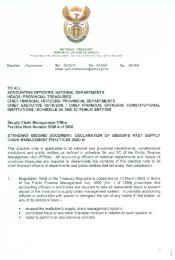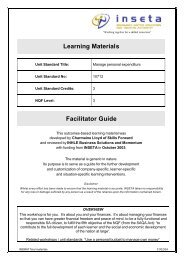SSP Brochure:Layout 1 - INSETA
SSP Brochure:Layout 1 - INSETA
SSP Brochure:Layout 1 - INSETA
You also want an ePaper? Increase the reach of your titles
YUMPU automatically turns print PDFs into web optimized ePapers that Google loves.
ANNEXURE CMETHODOLOGY USED TO ESTIMATE THE NUMBER OF BLACK MANAGERSNEEDED BY THE INSURANCE SECTORThe following steps were followed to arrive at estimates of Black managers needed by the insurance sector over the period 2005 to 2010.It is important to note that it was assumed that the attrition rates for Black managers would be the same as that of white managers.Although the turnover of black managers in companies may be high, it is not certain that they leave the sector altogether. Also, blackmanagers may be younger than their white counterparts and therefore a smaller proportion may retire over the five-year period.a) First, current employment of managers was obtained from the Survey of Employment, Scarce and Critical skills conducted in 2005. Thedistribution of managers across the two levels, senior and executive managers and middle and junior managers was obtained from theWSPs submitted to the <strong>INSETA</strong> for the year 2006/2007. The WSPs represented more than 80% if the employees in the sector andtherefore it can be regarded as fairly representative of the sector as a whole. The distinction between these two levels of managementwas made by the employers themselves and may differ between organisations.b) The current employment distribution was also obtained from the WSPs as explained in a) above.c) The target distribution for 2010 was obtained by:Scenario 1 – keeping the distributions more or less as they were in the Year 2006/2007 WSPs andScenario 2 – arbitrarily increasing the black male and black female components beyond the minimum targets set in the FSC.d) The target employment for 2010 was obtained by applying the target distributions for 2010 to the target employment figure of 14 856.This is the number of managers that the industry would employ in 2010 if employment would grow by 1.9% per year. In Scenario 1the black male, female and white distributions were held at the level at which they currently are (as reflected in the WSPs submittedin June 2007) and in Scenario 2 they were increased as explained above.Total Managers NeededThe total number of managers needed over the five-year period at the different levels and in the different population and gender groupswas calculated by providing for the growth in employment as explained in d) above and the replacement demand calculated by the modeldeveloped for the <strong>SSP</strong> (See Chapter 2). Thus, all the assumptions made for the model also apply to this extension of the model. The numberof managers needed annually was calculated by dividing the number needed over the five-year period by five. The results shown in thetable below indicate that if the targets for black managers were raised to the levels indicated in Scenario 2, the attrition of white managerswould have to be faster than that allowed for in the model – approximately 80 white managers need to leave in addition to the ones thatwould naturally leave the sector. Alternatively, employment growth in the sector would have to be faster in order to create more spacefor the transformation of the management cadres.a) Current employmentBlackMaleBlackFemaleWhiteTotalSenior and executive management 925 526 4 959 6 410Middle to junior management 1 607 1 444 4 061 7 112Total 2 531 1 971 9 020 13 522b) Current employment distributionBlackMaleBlackFemaleWhiteTotalSenior and executive management 14.43 8.21 77.36 100Middle to junior management 22.59 20.31 57.10 100Total 18.72 14.57 66.70 100c) Target distribution for 2010BlackMaleBlackFemaleScenario 1 Scenario 2White Total BlackMaleBlackFemaleSenior and executive management 15 10 75 100 20 15 65 100Middle to junior management 24 21 55 100 30 30 40 100d)Target employment for 2010BlackMaleBlackFemaleWhite Total BlackMaleBlackFemaleSenior and executive management 1 056 704 5 282 7 042 1 408 1 056 4 577 7 042Middle to junior management 1 875 1 641 4 298 7 814 2 344 2 344 3 126 7 814Total 2 932 2 345 9 579 14 856 3 753 3 401 7 703 14 856WhiteWhiteTotalTotal<strong>INSETA</strong> Sector Skills Plan - page 48
















